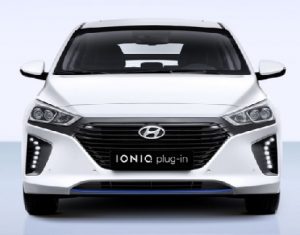 Hyundai Motor Company has been surging forward in the global auto market, and plans to become No. 2 in green car sales after Toyota by 2020. Hyundai unveiled its signature brand last month at the New York Auto Show – the Ioniq – which will be the auto industry’s first-ever model available in hybrid, plug-in hybrid, and battery-electric iterations and built on the same drivetrain. It will be rolling out later this year. Within the next four years, the Korean automaker intends to flood the market with 26 green vehicles, including hybrid, plug-in hybrid, all-electric, and hydrogen-powered models.
Hyundai Motor Company has been surging forward in the global auto market, and plans to become No. 2 in green car sales after Toyota by 2020. Hyundai unveiled its signature brand last month at the New York Auto Show – the Ioniq – which will be the auto industry’s first-ever model available in hybrid, plug-in hybrid, and battery-electric iterations and built on the same drivetrain. It will be rolling out later this year. Within the next four years, the Korean automaker intends to flood the market with 26 green vehicles, including hybrid, plug-in hybrid, all-electric, and hydrogen-powered models.
With 8.01 million vehicles sold through its Hyundai, Kia, and Genesis brands in 2015, Hyundai Motor Co. became the fifth largest global automaker; and the third largest Asian vehicle manufacturer after Toyota and Nissan. Kia and Hyundai surpassed Japanese brands for the first time last year in the J.D. Power 2015 U.S. Initial Quality Study. The automaker plans to sell 300,000 electrified vehicles by 2020, a sizeable gain over the 70,000 electrified vehicles the company sold last year.
Here’s Hyundai’s formula to become No. 2 in “eco-friendly vehicles” –
- The near-term Hyundai lineup will include the Sonata hybrid and plug-in hybrid; Ioniq hybrid, plug-in hybrid, and battery electric; Grandeur hybrid; and its Tucson Fuel Cell. The Kia brand will offer the Optima hybrid and plug-in hybrid; Soul EV; Cadenza hybrid; and the upcoming Niro Hybrid.
- Hyundai says the 2017 Ioniq plug-in hybrid will travel 25 miles on electric power alone in its plug-in hybrid version compared to Toyota’s 22 miles in the new Prius Prime. The fully electric Ioniq will travel 110 miles per full battery charge, which surpasses the current Nissan Leaf but will be overtaken by the upcoming 200 miles-per-charge models.
- The Ioniq Electric battery electric version will use a 28 kWh lithium-polymer battery, and is expected to deliver 155 miles per charge on the European test cycle; and would likely be lower in the U.S. As previously stated, that could be about 110 miles per charge for the U.S. rating. The electric motor will have 118 horsepower and 218 lb.-ft. of torque. Its top speed is 103 mph.
- Hyundai’s strategy appears to be driven by a mix of regulatory compliance, an environmental-friendly philosophy, and profitability. “With a goal of having a fleet-wide average of 54.5 MPG by 2025, we’re leading the future of eco-friendly vehicles,” according to Hyundai’s website. Hyundai’s Blue Drive Strategy is another element of Hyundai’s corporate strategy for fuel efficient vehicles and environmentally-friendly vehicle technologies. This has started with some of the Hyundai vehicles such as the i10, more fuel efficient version of the Elantra and Accent, the company said.
- Hyundai has been far behind other OEMs in its green car lineup, bringing its Sonata Hybrid to market in 2010 and the Tucson Fuel Cell in 2014. It has been driven by Toyota’s leadership, and it does need to become profitable for it to be a viable option. “Except for Toyota, I can achieve some competitiveness against other companies,” said Lee Ki-Sang, head of Hyundai’s eco-car powertrain division. “Our target is before 2020, we would like to make profits on these eco-friendly vehicles,” he said.
- Hyundai Tucson Fuel Cell drivers have accumulated more than one million miles (as of mid-February) in Southern California since introduction of the hydrogen-powered car in June 2014. The first mass-market produced fuel cell vehicles has been sold to about 100 owners (in February). The Tucson fuel cell model is currently available on a 36-month lease for $499 a month with $2,999 as the down payment.
- At the Chicago Auto Show, Kia unveiled the 2017 Optima Hybrid and Optima PHEV plug-in hybrid that can travel 27 miles on electricity alone. The Kia Optima recently received a complete redesign. The Kia Optima Hybrid uses the new Optima body, as well as a similar powertrain to the latest generation of the related Hyundai Sonata Hybrid. Like the Sonata, the Optima also gets a plug-in hybrid variant for the first time.
- Kia also introduced the Niro, the company’s first dedicated hybrid nameplate. Along with being Kia’s first dedicated hybrid, it will have an entirely unique body style. The 2017 Kia Niro is scheduled to go on sale late this year.
- In November, the 2016 Sonata Plug-in Hybrid became the first plug-in hybrid electric vehicle launched by Hyundai and comes with a 27 mile battery range. The Sonata Plug-in Hybrid’s 9.8 kWh lithium polymer battery system helps deliver 99 MPGe.



